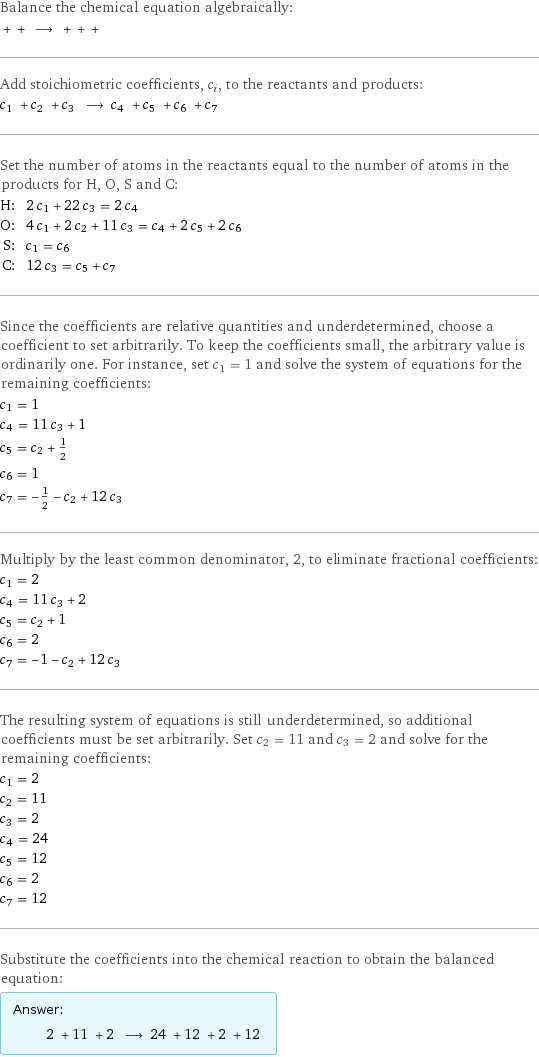Input interpretation

sulfuric acid + oxygen + sucrose ⟶ water + carbon dioxide + sulfur dioxide + activated charcoal
Balanced equation

Balance the chemical equation algebraically: + + ⟶ + + + Add stoichiometric coefficients, c_i, to the reactants and products: c_1 + c_2 + c_3 ⟶ c_4 + c_5 + c_6 + c_7 Set the number of atoms in the reactants equal to the number of atoms in the products for H, O, S and C: H: | 2 c_1 + 22 c_3 = 2 c_4 O: | 4 c_1 + 2 c_2 + 11 c_3 = c_4 + 2 c_5 + 2 c_6 S: | c_1 = c_6 C: | 12 c_3 = c_5 + c_7 Since the coefficients are relative quantities and underdetermined, choose a coefficient to set arbitrarily. To keep the coefficients small, the arbitrary value is ordinarily one. For instance, set c_1 = 1 and solve the system of equations for the remaining coefficients: c_1 = 1 c_4 = 11 c_3 + 1 c_5 = c_2 + 1/2 c_6 = 1 c_7 = -1/2 - c_2 + 12 c_3 Multiply by the least common denominator, 2, to eliminate fractional coefficients: c_1 = 2 c_4 = 11 c_3 + 2 c_5 = c_2 + 1 c_6 = 2 c_7 = -1 - c_2 + 12 c_3 The resulting system of equations is still underdetermined, so additional coefficients must be set arbitrarily. Set c_2 = 11 and c_3 = 2 and solve for the remaining coefficients: c_1 = 2 c_2 = 11 c_3 = 2 c_4 = 24 c_5 = 12 c_6 = 2 c_7 = 12 Substitute the coefficients into the chemical reaction to obtain the balanced equation: Answer: | | 2 + 11 + 2 ⟶ 24 + 12 + 2 + 12
Structures

+ + ⟶ + + +
Names

sulfuric acid + oxygen + sucrose ⟶ water + carbon dioxide + sulfur dioxide + activated charcoal
Chemical names and formulas
![| sulfuric acid | oxygen | sucrose | water | carbon dioxide | sulfur dioxide | activated charcoal Hill formula | H_2O_4S | O_2 | C_12H_22O_11 | H_2O | CO_2 | O_2S | C name | sulfuric acid | oxygen | sucrose | water | carbon dioxide | sulfur dioxide | activated charcoal IUPAC name | sulfuric acid | molecular oxygen | (2R, 3S, 4S, 5S, 6R)-2-[(2S, 3S, 4S, 5R)-3, 4-dihydroxy-2, 5-bis(hydroxymethyl)oxolan-2-yl]oxy-6-(hydroxymethyl)oxane-3, 4, 5-triol | water | carbon dioxide | sulfur dioxide | carbon](../image_source/4c655b455ba634fbf089a7d5e1b84f5e.png)
| sulfuric acid | oxygen | sucrose | water | carbon dioxide | sulfur dioxide | activated charcoal Hill formula | H_2O_4S | O_2 | C_12H_22O_11 | H_2O | CO_2 | O_2S | C name | sulfuric acid | oxygen | sucrose | water | carbon dioxide | sulfur dioxide | activated charcoal IUPAC name | sulfuric acid | molecular oxygen | (2R, 3S, 4S, 5S, 6R)-2-[(2S, 3S, 4S, 5R)-3, 4-dihydroxy-2, 5-bis(hydroxymethyl)oxolan-2-yl]oxy-6-(hydroxymethyl)oxane-3, 4, 5-triol | water | carbon dioxide | sulfur dioxide | carbon